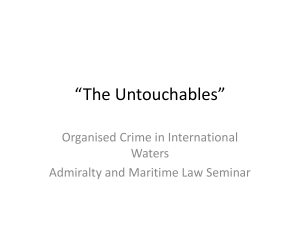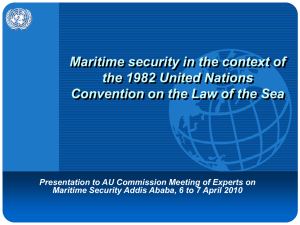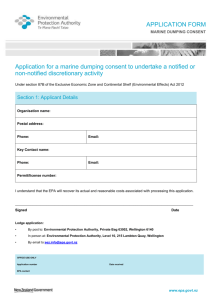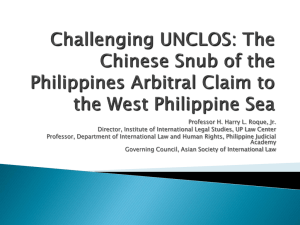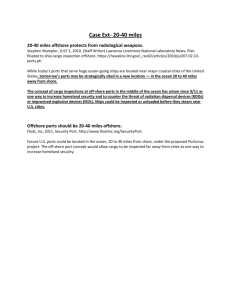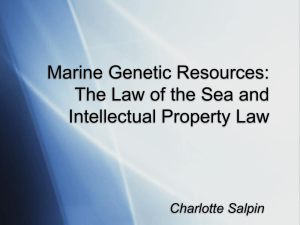O CLOSE ENCOUNTERS AT SEA Impeccable Captain Raul Pedrozo, JAGC, U.S. Navy
advertisement
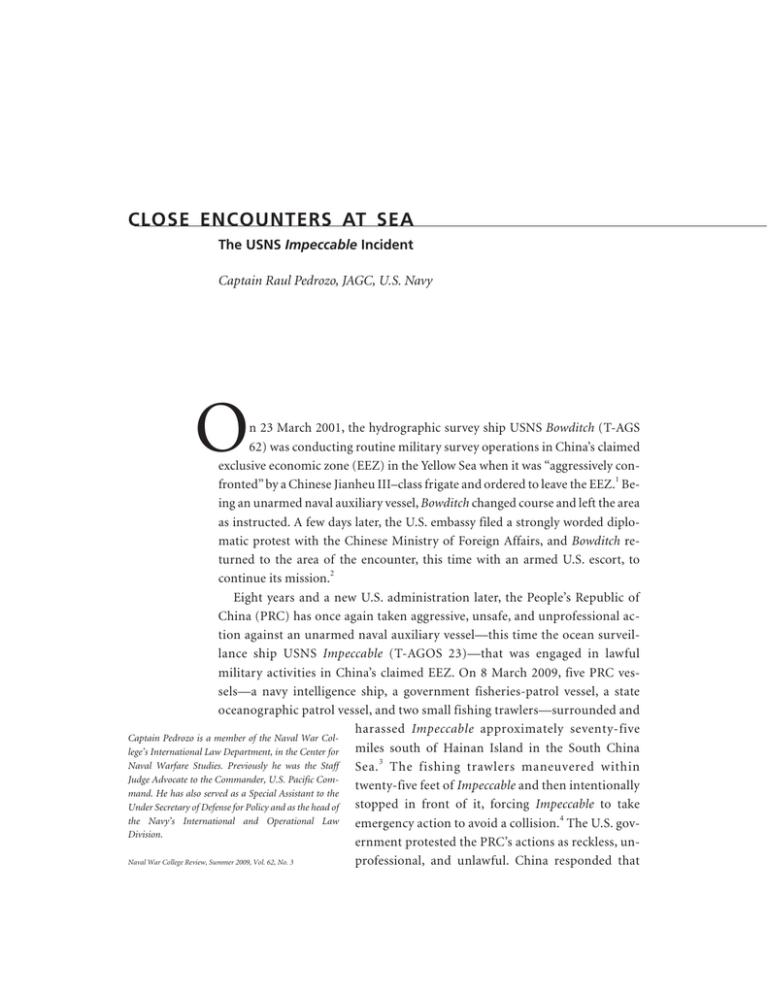
CLOSE ENCOUNTERS AT SEA The USNS Impeccable Incident Captain Raul Pedrozo, JAGC, U.S. Navy O n 23 March 2001, the hydrographic survey ship USNS Bowditch (T-AGS 62) was conducting routine military survey operations in China’s claimed exclusive economic zone (EEZ) in the Yellow Sea when it was “aggressively con1 fronted” by a Chinese Jianheu III–class frigate and ordered to leave the EEZ. Being an unarmed naval auxiliary vessel, Bowditch changed course and left the area as instructed. A few days later, the U.S. embassy filed a strongly worded diplomatic protest with the Chinese Ministry of Foreign Affairs, and Bowditch returned to the area of the encounter, this time with an armed U.S. escort, to 2 continue its mission. Eight years and a new U.S. administration later, the People’s Republic of China (PRC) has once again taken aggressive, unsafe, and unprofessional action against an unarmed naval auxiliary vessel—this time the ocean surveillance ship USNS Impeccable (T-AGOS 23)—that was engaged in lawful military activities in China’s claimed EEZ. On 8 March 2009, five PRC vessels—a navy intelligence ship, a government fisheries-patrol vessel, a state oceanographic patrol vessel, and two small fishing trawlers—surrounded and harassed Impeccable approximately seventy-five Captain Pedrozo is a member of the Naval War Colmiles south of Hainan Island in the South China lege’s International Law Department, in the Center for 3 Naval Warfare Studies. Previously he was the Staff Sea. The fishing trawlers maneuvered within Judge Advocate to the Commander, U.S. Pacific Comtwenty-five feet of Impeccable and then intentionally mand. He has also served as a Special Assistant to the stopped in front of it, forcing Impeccable to take Under Secretary of Defense for Policy and as the head of 4 the Navy’s International and Operational Law emergency action to avoid a collision. The U.S. govDivision. ernment protested the PRC’s actions as reckless, unNaval War College Review, Summer 2009, Vol. 62, No. 3 professional, and unlawful. China responded that Form Approved OMB No. 0704-0188 Report Documentation Page Public reporting burden for the collection of information is estimated to average 1 hour per response, including the time for reviewing instructions, searching existing data sources, gathering and maintaining the data needed, and completing and reviewing the collection of information. Send comments regarding this burden estimate or any other aspect of this collection of information, including suggestions for reducing this burden, to Washington Headquarters Services, Directorate for Information Operations and Reports, 1215 Jefferson Davis Highway, Suite 1204, Arlington VA 22202-4302. Respondents should be aware that notwithstanding any other provision of law, no person shall be subject to a penalty for failing to comply with a collection of information if it does not display a currently valid OMB control number. 1. REPORT DATE 3. DATES COVERED 2. REPORT TYPE 2009 00-00-2009 to 00-00-2009 4. TITLE AND SUBTITLE 5a. CONTRACT NUMBER Close Encounters at Sea: The USNS Impeccable Incident 5b. GRANT NUMBER 5c. PROGRAM ELEMENT NUMBER 6. AUTHOR(S) 5d. PROJECT NUMBER 5e. TASK NUMBER 5f. WORK UNIT NUMBER 7. PERFORMING ORGANIZATION NAME(S) AND ADDRESS(ES) Naval War College,686 Cushing Road,Newport,RI,02841-1207 9. SPONSORING/MONITORING AGENCY NAME(S) AND ADDRESS(ES) 8. PERFORMING ORGANIZATION REPORT NUMBER 10. SPONSOR/MONITOR’S ACRONYM(S) 11. SPONSOR/MONITOR’S REPORT NUMBER(S) 12. DISTRIBUTION/AVAILABILITY STATEMENT Approved for public release; distribution unlimited 13. SUPPLEMENTARY NOTES 14. ABSTRACT 15. SUBJECT TERMS 16. SECURITY CLASSIFICATION OF: a. REPORT b. ABSTRACT c. THIS PAGE unclassified unclassified unclassified 17. LIMITATION OF ABSTRACT 18. NUMBER OF PAGES Same as Report (SAR) 11 19a. NAME OF RESPONSIBLE PERSON Standard Form 298 (Rev. 8-98) Prescribed by ANSI Std Z39-18 102 NAVAL WAR COLLEGE REVIEW Impeccable’s presence in China’s claimed EEZ had been in violation of Chinese 5 domestic law and international law. Impeccable returned to the area the next day under escort of a guided-missile destroyer, the USS Chung-Hoon (DDG 93). The PRC position with regard to coastal-state control over foreign military activities in the EEZ is threefold: national security interests, resource/environmental protection, and jurisdiction over marine scientific research (MSR). As discussed in detail below, the PRC’s position is inconsistent with international law (including the 1982 UN Convention on the Law of the Sea) and state practice. The PRC’s position is also somewhat disingenuous, as PRC naval units routinely conduct submarine operations, military survey operations, and surveillance/intelligence-collection operations in foreign EEZs throughout the Asia-Pacific region. In short, nothing in the 1982 UN Convention on the Law of the Sea (UNCLOS) changes the right of military forces of all nations to conduct military activities in the exclusive economic zone. Moreover, prior to and subsequent to the adoption of UNCLOS military forces have routinely conducted military activities seaward of the twelve-nautical-mile territorial sea without coastal-state notice or consent. These activities include task-force maneuvering, flight operations, military exercises, weapons testing and firing, surveillance and reconnaissance operations (and other intelligence-gathering activities), and military marine data collection (military surveys). THE EXCLUSIVE ECONOMIC ZONE All coastal states may claim a two-hundred-nautical-mile EEZ (article 57). Combined, these EEZ claims encompass a large area of the world’s ocean—nearly 30 6 percent—that twenty years ago was considered to be high seas. The EEZ is a creature of UNCLOS, which created it for the purpose of giving coastal states greater control over the resources adjacent to their coasts out to two hundred nautical miles (articles 56 and 57). Coastal states were also granted jurisdiction in the EEZ over artificial islands and structures, MSR, and protection and preservation of the environment (article 56). Unfortunately, over the years some coastal states like China have sought to expand their jurisdiction in the EEZ by attempting to exercise control over non-resource-related activities, including many military activities. These illegal coastal-state restrictions in the EEZ take many forms, including prohibitions on military marine data collection (military surveys and hydrographic surveys), requirements of prior notice or consent to conduct military activities, environmental constraints on sovereign immune vessels and aircraft, and national-security restrictions. These excessive claims have no basis in customary international law or in UNCLOS, and they have been diplomatically PEDROZO protested by the U.S. government and operationally challenged by the U.S. Navy and Air Force under the Freedom of Navigation Program since 1979. Military Activities in the EEZ Military uses of the seas are clearly a recognized right under international law. For centuries, the navies of the world have operated and trained in waters seaward of other nations’ territorial seas without constraint or the consent of coastal states. This extensive state practice confirms that military activities at sea are lawful under customary international law and consistent with article 2(4) of the UN Charter. UNCLOS reaffirms this conclusion by limiting military activities in only a few narrow circumstances: while ships are engaged in innocent passage, transit passage, and archipelagic-sea-lanes passage (ASLP) (articles 19, 20, 39, 40, 52, and 54). Other international instruments also support the position that military activities at sea are lawful. For example, the International Maritime Organization/International Hydrographic Organization World-wide Navigational Warning Service specifically recognizes military activities at sea, such as naval exercises and missile firings, as proper, for which “naval area” 7 warnings are to be issued. Annex 15 to the Chicago Convention regarding Aeronautical Information Services similarly provides that military exercises that 8 pose hazards to civil aviation are appropriate subjects for notices to airmen. Nothing in UNCLOS or state practice changes the right of military forces of all nations to conduct military activities in the exclusive economic zone without coastal-state notice or consent. The EEZ was not created to regulate military activities. Proposals during the Third UN Conference on the Law of the Sea (UNCLOS III) to include residual coastal-state security interest rights in the 9 EEZ were considered and rejected. UNCLOS article 56 makes clear that coastal states have limited sovereign rights in the EEZ for the purpose of exploring, exploiting, conserving, and managing the natural resources of the zone and with regard to other activities for the economic exploitation and exploration of the zone. The coastal state also has limited jurisdiction with regard to the establishment and use of artificial islands, installations, and structures, marine scientific research, and the protection and preservation of the marine environment. In exercising its rights and performing its duties in the EEZ, the coastal state is to have due regard to the rights and duties of other states and act in a manner compatible with the provisions of UNCLOS. Pursuant to article 58 of UNCLOS, all states have the high-seas freedoms of navigation and overflight referred to in article 87 of UNCLOS and other internationally lawful uses of the sea related to these freedoms, such as those associated with the operation of ships and aircraft. As evidenced by long-standing state practice, the term “other internationally lawful uses” does not refer solely 103 104 NAVAL WAR COLLEGE REVIEW to navigation and overflight rights but includes all lawful military activities. This point was clearly articulated by the American delegation to the UNCLOS III 1983: All States continue to enjoy in the [EEZ] traditional high seas freedoms of navigation and overflight and the laying of submarine cables and pipelines, and other internationally lawful uses of the sea related to those freedoms, which remain qualitatively and quantitatively the same as those freedoms when exercised seaward of the zone. Military operations, exercises and activities have always been regarded as internationally lawful uses of the sea. The right to conduct such activities will continue to be enjoyed by all States in the exclusive economic zone.10 The only limitation on the user state’s rights and freedoms is a reciprocal dueregard requirement. In this regard, one can envision limited situations where legitimate military activities may be adjusted to respect coastal-state resource rights in the EEZ—for example, a proposed weapons exercise in close proximity to an active offshore oil platform. But these situations are the exception, not the rule, and cannot be dictated unilaterally by the coastal state. As discussed below, although foreign sovereign-immune vessels do not have to comply with coastal nations’ domestic environmental regulations, U.S. Navy vessels operate with due regard for the marine environment. For example, when operating low- and midfrequency sonar systems anywhere around the world, U.S. Navy vessels voluntarily apply marine-mammal mitigation measures that provide extensive protection for the environment based on the best available science. The PRC has recently indicated that sonar use may harm marine mammals and fish stocks in its EEZ. However, there is no evidence that the Navy’s sonar use, while applying these scientific protective measures, impacts either marine 11 mammals or fish. These measures are designed to allow the Navy to train realistically without harming the environment, and they far exceed the “due regard” requirement of article 58. In short, the PRC has no right under international law to force training restrictions or mitigation measures on foreign sovereign immune vessels operating in its EEZ. Although coastal states enjoy environmental jurisdiction in the EEZ, application of environmental controls on foreign warships, naval auxiliaries (like Impeccable and Bowditch), and other government-owned or -operated noncommercial vessels and aircraft operating in the EEZ is strictly limited. Article 236 makes clear that the provisions of UNCLOS “regarding the protection and preservation of the marine environment do not apply to any warship, naval auxiliary, other vessels or aircraft owned or operated by a state and used, for the time being, only on government non-commercial service.” The only requirement is that such vessels and aircraft are to act in a manner consistent PEDROZO with the environmental provisions of UNCLOS, so far as is reasonable and practicable to do so, and to the extent that it does not impair the operations or operational capabilities of such vessels and aircraft. It is also important to note that while UNCLOS does place certain limitations on military activities at sea, these restrictions are limited to ships engaged in innocent passage, transit passage, and ASLP. For example, article 19 limits certain military activities in the territorial sea, such as threat or use of force, use of weapons, intelligence gathering, acts of propaganda, launching and landing of aircraft and other military devices, and marine data collection (hydrographic surveys and military surveys). Article 52 applies these same limitations to archipelagic waters. Articles 20 and 52 provide that submarines must navigate on the surface when in innocent passage in the territorial sea or archipelagic waters. Articles 39 and 54 prohibit the threat or use of force when ships are engaged in transit passage or archipelagic-sea-lanes passage. Finally, articles 40 and 54 prohibit survey activities for ships engaged in transit passage or ASLP. No similar limitations are included in part V of UNCLOS and therefore they do not apply to foreign warships, military aircraft, or other sovereign, “immune” ships and aircraft in and over the EEZ. This conclusion is confirmed by the negotiating history of UNCLOS: efforts to include “security interests” as a protected 12 coastal-state interest in the EEZ failed. Chinese reliance on the “peaceful purposes” provisions of UNCLOS (articles 88, 141, and 301) to regulate military activities in the EEZ is also clearly misplaced. Article 301 provides that “in exercising their rights and performing their duties under this Convention, States Parties shall refrain from any threat or use of force against the territorial integrity or political independence of any state, or in any other manner inconsistent with the principles of international law embodied in the Charter of the United Nations.” Identical language can be found in article 2(4) of the UN Charter and in UNCLOS article 19.2(a). State practice since the adoption of UNCLOS confirms that the “peaceful purposes” provisions do not create new rights or obligations, nor do they impose restraints on traditional military operations at sea that are consistent with international law, including the UN Charter. These provisions simply require states to exercise their rights and perform their duties under UNCLOS in accordance with their duty under article 2(4) of the UN Charter to refrain from the threat or use of force against the territorial integrity or political independence of any state. Military surveillance and reconnaissance operations in international airspace, however, do not equate to a “threat or use of force against the territorial integrity or political independence of any state.” Long-standing state practice, as well as UNCLOS, supports the conclusion that such operations are lawful and consistent with the UN Charter. In this regard, UNCLOS article 19 makes a clear 105 106 NAVAL WAR COLLEGE REVIEW distinction between a “threat or use of force against the sovereignty, territorial integrity or political independence of the coastal state” and “any act aimed at collecting information to the prejudice of the defense or security of the coastal 13 state.” Both are prohibited in the territorial sea for ships engaged in innocent passage, but they are clearly distinct and independent activities. UNCLOS article 19(2) makes a similar distinction between “threat or use of force” and other military activities at sea that are consistent with article 2(4) of the UN Charter, such as military exercises, weapons testing, use of ordnance, and military marine data collection (military surveys and hydrographic surveys). Marine Data Collection in the EEZ Although coastal states can clearly regulate marine scientific research in the exclusive economic zone, marine data collection is much broader. “Marine data collection” is a general term referring to all types of collection activities at sea, including MSR, military surveys, and hydrographic surveys. UNCLOS applies different rules to each of these activities, depending on where the activities take place. “Marine scientific research,” in contrast, indicates activities undertaken to expand scientific knowledge of the marine environment and its processes. Classes of data collected could be related to oceanography, marine biology, fisheries research, scientific ocean drilling or coring, or geological or geophysical studies. The data is usually shared among the public and scientific communities. Hydrographic surveys, on the other hand, are conducted to support safety of navigation. The data collected is normally used to produce nautical charts and similar products. That is, hydrographic survey is not MSR. Neither is military survey considered to be MSR, because it is conducted for military, not scientific, purposes. The data collected may be either classified or unclassified; it is normally not released to the public or scientific community unless it is unclassified and was collected on the high seas. Such collected data could be oceanographic, hydrographic, marine geological or geophysical, chemical, acoustic, or biological. Although the means of data collection are often similar and to the coastal state may appear indistinguishable from marine scientific research, it is the military or safety use to which the data is put that distinguishes military surveys and hydrographic surveys from MSR. On the basis of these distinctions and the plain language of UNCLOS, military surveys and hydrographic surveys remain high-seas freedoms and may be conducted in foreign EEZs and on foreign continental shelves without coastal-state notice or consent. Coastal-state consent is only required for such survey activities in territorial seas and archipelagic waters. The following provisions of UNCLOS support this conclusion: PEDROZO • Research or survey activities are inconsistent with innocent passage (article 19[2][j]). • Ships in transit passage or archipelagic-sea-lanes passage may not carry out research or survey activities (articles 40 and 54). • Part XIII applies only to MSR and does not refer to survey activities. WHY THIS IS IMPORTANT: THE EP-3 INCIDENT In order to avoid conflict and potential miscalculations at sea and in the air between U.S. and Chinese forces, both sides need to have a clear understanding of their respective rights in and over the EEZ as coastal and user states. We certainly do not want a repeat of the EP-3 incident.14 On the morning of 1 April 2001, a week after the Bowditch incident discussed earlier, two Chinese F-8 fighter aircraft intercepted a U.S. EP-3 that was conducting a routine reconnaissance flight about seventy miles south/southeast of Hainan Island. After making several close approaches to the American aircraft, one of the F-8s lost control and collided with the EP-3. The F-8 was chopped in half; the nose cone and number-one propeller of the EP-3 were severely damaged. The Chinese pilot ejected but was never found and was presumed dead. The EP-3 was forced to make an emergency landing at the Lingshui military airfield on Hainan. The cause of the collision is still a matter of dispute. The PRC claims that the EP-3 swerved into the flight path and rammed the F-8. The United States claims that the F-8 ran into the larger, slower, and less maneuverable EP-3. I will not go into the details here but would only suggest that the laws of physics do not support the Chinese position—and leave it at that. Some of the legal issues raised by the PRC following this incident included the validity of coastal-state security interests in the exclusive economic zone, the legality of surveillance and reconnaissance flights over the EEZ, and the applicability of the due-regard requirement when conducting air intercepts. As previously discussed, coastal states lack security interests in the EEZ. Nothing in UNCLOS supports the PRC position. Similarly, the Chinese position that the freedom of overflight reflected in UNCLOS article 58 is a narrow right, including only the right to transit the airspace above the EEZ, is not supported by UNCLOS, other international agreements, or state practice. On the contrary, the negotiating history of UNCLOS and state practice before, during, and after UNCLOS support the conclusion that freedoms of navigation and overflight in the EEZ are broad freedoms; it is coastal-state rights in the EEZ that are narrowly limited. As we have seen, UNCLOS article 58 is quite clear: all states enjoy the freedoms of navigation and overflight and other internationally lawful uses of the seas related to these freedoms, such as those associated with the operation of 107 108 NAVAL WAR COLLEGE REVIEW ships and aircraft. Long-standing state practice supports the position that surveillance and reconnaissance operations conducted in international airspace beyond the twelve-nautical-mile territorial sea are lawful activities. Since the end of World War II, surveillance and reconnaissance operations in international airspace have become a matter of routine. Many nations, including the PRC, engage in such activities on a routine basis. Moreover, as previously discussed, UNCLOS article 19.2(c) prohibits intelligence-gathering activities by ships engaged in innocent passage through the territorial sea—as noted above, no similar prohibition is contained in part V of UNCLOS, and therefore, surveillance and reconnaissance activities are permitted in the EEZ. The PRC has an obligation under UNCLOS article 56 to exercise its limited resource-related rights in the EEZ with due regard for the rights of other states to engage in lawful military activities, including surveillance and reconnaissance operations, in the zone. With regard to surveillance and reconnaissance flights over the EEZ, it is also important to note that coastal states lack competence to regulate military activities in the airspace above the EEZ. Articles 2 and 49 of UNCLOS make clear that the airspace above the territorial sea and archipelagic waters is national airspace, subject to coastal-state/archipelagic-state sovereignty. Similar language is found in article 1 of the Convention on International Civil Aviation of 1944 (known as the Chicago Convention) with regard to the territorial sea. Beyond the twelve-mile limit, however, is international airspace. Neither UNCLOS nor the Chicago Convention grant coastal states any authority over military aircraft operating in international airspace above the EEZ. Coastal-state sovereign rights in the zone are limited to the seabed, its subsoil, and the waters superjacent to the seabed, with one exception—the coastal state has sovereign rights with regard to the production of energy from the winds (UNCLOS article 56). Therefore, nothing in UNCLOS provides a legal basis for regulating military activities in the airspace above the EEZ. UNCLOS does, however, clearly provide that in the EEZ all states enjoy, among other things, freedom of navigation and overflight and other internationally lawful uses of the sea. The only caveat is that in exercising their high-seas freedoms in the EEZ, states shall have “due regard” to the rights and duties of the coastal state and shall comply with the laws and regulations adopted by the coastal state in accordance with the provisions of UNCLOS and other rules of international law “in so far as they are not incompatible” with part V of UNCLOS (article 58, emphasis added). Similarly, the provisions of the Chicago Convention do not apply to state aircraft, which include all aircraft used in military, customs, and police services. The only requirement is that state aircraft 15 fly with “due regard” for the safety of navigation of civil aircraft. PEDROZO THE WAY FORWARD The PRC can expect U.S. warships, military aircraft, and naval auxiliaries like Impeccable and Bowditch to continue to operate in its claimed EEZ, in accordance with the rights and freedoms guaranteed to all nations under international law. If the PRC has an issue with continued American military presence in its EEZ, the PRC should raise its concerns not via bridge-to-bridge communications, in the open press, or via diplomatic protests but directly with the United States and attempt to reach a mutually acceptable solution within the context of the Military Maritime Consultative Agreement (MMCA).16 Some have suggested that it may be time for the United States to negotiate an INCSEA-like agreement with China to avoid confrontations of this nature.17 However, I do not believe such an agreement is necessary, as the MMCA was specifically established to facilitate consultations between the U.S. Department of Defense and the PRC Ministry of National Defense for the “purpose of promoting common understandings regarding activities undertaken by their respective maritime 18 and air forces when operating in accordance with international law.” Unfortunately, MMCA has failed to live up to expectations in this regard, primarily because of the PRC’s unwillingness to engage in a serious debate on this important issue. A solution can be reached if both sides act in good faith and apply themselves, but as the saying goes, “it takes two to tango.” I would point to the 1989 Uniform Interpretation of Rules of International Law Governing Innocent Passage, agreed to by the United States and the Soviet Union after a 1988 Black Sea “bumping” incident, as an example of how two nations with differing views can reach a mutually acceptable solution to a politically charged national-security issue. (In the 1988 case, the issue was the right of innocent passage of warships through the territorial sea without prior notice to or consent of the coastal 19 state.) Until a mutually acceptable solution is reached, PRC ships and aircraft should immediately cease their aggressive, unlawful, and unsafe maneuvers in the vicinity of U.S. ships and aircraft, as was recently witnessed near Impeccable. In addition to complying with their legal obligations under the Collision Regulations, Chinese ships and aircraft should—as has been suggested by the United States on numerous occasions—also abide by internationally recognized codes and signals. The Code for Unalerted Encounters at Sea, or CUES, issued by the Western Pacific Naval Symposium, offers safety measures and procedures, as well as a means to limit mutual interference and uncertainty and to facilitate communication when warships, submarines, public vessels, or naval aircraft make contact. Standard safety procedures are contained in part 3, standard communications procedures in part 4, and “Selected Signals Vocabulary and Basic Maneuvering Instructions” in part 5. The NATO publication Multinational Maritime Tactical Instructions 109 110 NAVAL WAR COLLEGE REVIEW and Procedures, MTP 1(D), vol. 1, provides doctrine, tactics, instructions, and procedures governing the command, control, and maneuvering of all maritime units. Position, movement, and maneuvering are addressed in chapter 2, communications in chapter 3. The proliferation of excessive coastal-state restrictions on military activities in the exclusive economic zone should be a growing concern to all maritime nations. Such restrictions are inconsistent with the 1982 UN Convention on the Law of the Sea and customary international law, and they erode the balance of interests that was carefully crafted during the nine-year negotiations that led to the adoption of UNCLOS. All nations must remain engaged, both domestically and internationally, in preserving operational flexibility and ensuring that the balance of interests reflected in UNCLOS is not eroded any further. The bottom line is that while UNCLOS grants coastal states sovereign rights for the purpose of exploring, exploiting, conserving, and managing the natural resources in the EEZs, it does not authorize them to interfere with legitimate military activities, which include much more than just navigation and overflight. Accordingly, U.S. warships, military aircraft and other sovereign immune ships and aircraft will continue to exercise their rights and freedoms in foreign EEZs, including China’s, in accordance with international law. NOTES The views expressed in this paper are those of the author and do not represent the official policy or position of the Department of Defense, U.S. Pacific Command, or the Department of the Navy. 1. Chris Plante, “U.S. Quietly Resumes Surveillance Flights off China,” CNN.com/U.S., 15 May 2001; Mark Oliva, “Before EP-3, China Turned Away U.S. Research Ship in International Waters,” Stars and Stripes, 20 May 2001, available at www.stripes.com/; Shirley A. Kan (coordinator), China-U.S. Aircraft Collision Incident of April 2001: Assessments and Policy Implications, CRS Report for Congress (Washington, D.C.: Congressional Research Service, 10 October 2001). 2. Personal knowledge of the author, who served as the Special Assistant for Ocean Policy to the Under Secretary of Defense for Policy from June 1997 to September 2001. 3. Ann Scott Tyson, “China Draws U.S. Protest over Shadowing of Ships,” Washington Post, 10 March 2009, p. A8; Dan De Luce, “Chinese Ships ‘Harassed USNS Impeccable,’” Agence France-Presse, 10 March 2009, available at www.theaustralian.news.com.au/. 4. The unsafe actions by the PRC fishing vessels clearly violated their obligations under the “International Regulations for Preventing Collisions at Sea” (1972), in particular rules 8, 13, 15, 16, and 18. 5. “Naked Aggression: China and America Spar at Sea with an Impeccable Sense of Timing,” Economist, 12 March 2009. 6. This is particularly apparent in the AsiaPacific region, where there are a number of overlapping two-hundred-nautical-mile EEZ claims. 7. IMO/IHO World-wide Navigational Warning Service Guidance Document, annex 1, para. PEDROZO 4.2.1.3.12, www.iho.shom.fr/COMMITTEES/ CPRNW/A.706-17_as_amended.pdf. 8. “Chicago Convention,” annex 15, para. 5.1.1.1.(l). See the Aeronautical Information Services website, at Federal Aviation Administration, www.faa.gov/. 9. Satya N. Nandan and Shabtai Rosenne, gen. eds., United Nations Convention on the Law of the Sea 1982: A Commentary (Herndon, Va.: Brill, 1993), vol. 2 [hereafter Nandan and Rosenne, Commentary], pp. 521–44. 10. Official Records of the Third U.N. Conference on the Law of the Sea, vol. 17, Plenary Meetings, Doc.A/CONF.62/WS/37 and ADD.1 and 2 (New York: United Nations, n.d.), p. 243. 11. Some of the measures are “stationing specially trained lookouts to look for marine mammals, passive acoustic monitoring for marine mammals, establishing safety zones around ships where sonar power is reduced or shut down if marine mammals are sighted, and employing extra precautions during chokepoint exercises.” U.S. Department of Defense News Release 0041-07, 16 January 2008, available at www.defenselink.mil/ releases. Also see www.whalesandsonar.navy .mil. 12. Nandan and Rosenne, Commentary. 13. Compare articles 19.2(a) and 19.2(c). 14. The author was the legal adviser to the U.S. delegation sent to China to negotiate the release of the U.S. aircrew and return of the EP-3 aircraft. Facts recited in this section are based on personal knowledge of the author. 15. “Chicago Convention,” art. 3. 16. “Agreement between the Department of Defense of the United States of America and the Ministry of National Defense of the People’s Republic of China on Establishing a Consultation Mechanism to Strengthen Military Maritime Safety (19 January 1998) [hereafter MMCA],” available at www.state.gov/. 17. “Agreement with the United States on the Prevention of Incidents on or over the High Seas, May 25, 1972,” 23 UST 1168, TIAS no. 7379, 852 UNTS 151, as amended by the Protocol of May 22, 1973, 24 UST 1063, TIAS no. 7624, and by the 1998 exchange of diplomatic notes. 18. MMCA, art. I. 19. “Union of Soviet Socialist Republics–United States: Joint Statement with Attached Uniform Interpretation of Rules of International Law Governing Innocent Passage, 23 September 1989,” 28 ILM 1444 (1989). 111
